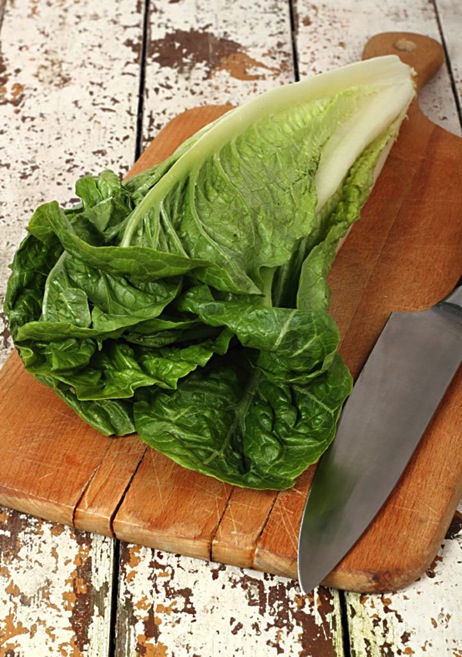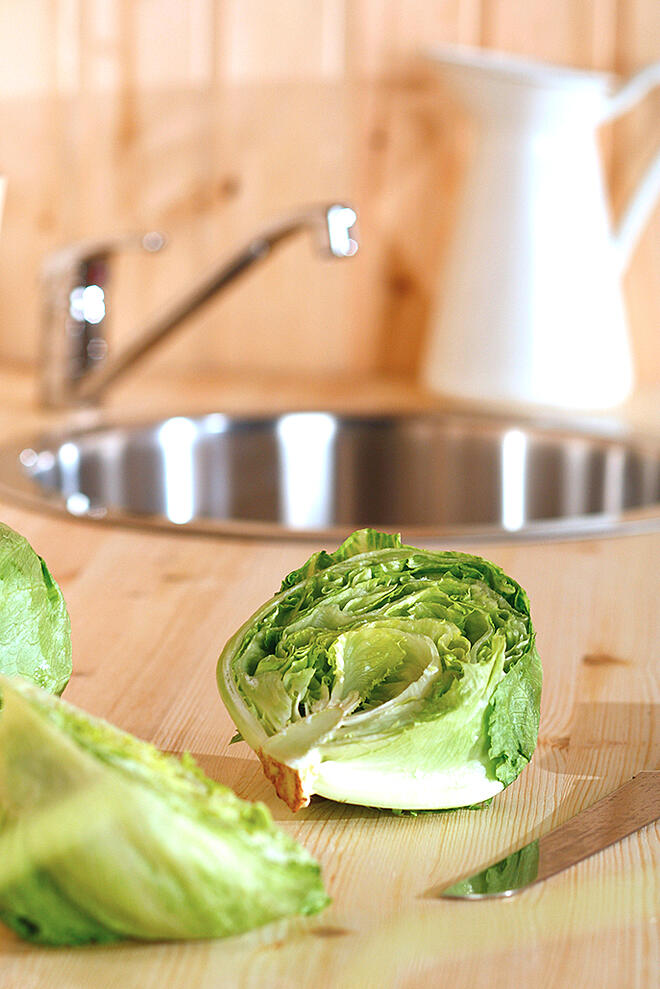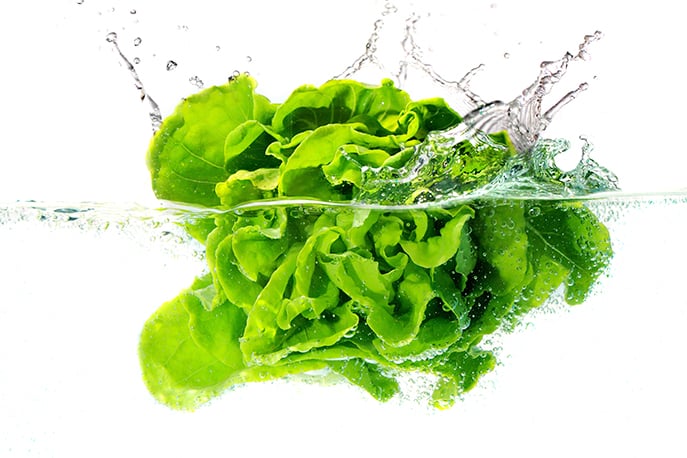We all know how easy it is to rip open a bag of lettuce for a pre-dinner salad, but what if fresh lettuce was just as easy and tasted much better? That would be great, right? Today, we will show you how to take whole heads of lettuce from the grocery store or farmers market and clean and store them properly so they last just as long, if not longer, than bagged lettuce. You’ll be able to use your gorgeous lettuce in salads as a main or side dish, and you can top it with the salad dressings we made earlier this week.
The instructions we have provided for cleaning and storing your lettuce are for romaine, butter, frisee and leaf lettuce varieties, or any leafy lettuce or green (such as kale.) Iceberg lettuce is somewhat different and is addressed at the end of this post.
If you are planning to clean and store your lettuce
Fill your very clean sink halfway with cold water. If your home is warm or your water is not cold, add a bowlful of ice to the sink to keep it chilly. This ensures your lettuce crisps and does not wilt.
Pick whole leaves off the lettuce and place into the cold water bath in your sink. Alternatively, you can cut off the base of your lettuce and the whole leaves will easily fall apart; place them in the cold water bath. Gently dunk and massage the lettuce to encourage the dirt to fall out of the leaves. Allow the lettuce to sit in the sink for 15-30 minutes without disruption. The dirt will fall from the leaves and settle onto the bottom of the sink, allowing the clean leaves to float on top, and the lettuce will become crisp. At this point, your lettuce is clean.

How to Store Lettuce
There are two methods for storing your lettuce, and they operate on similar principals. You are trying to remove excess water to prevent the leaves from wilting or losing valuable nutrients and flavor. The paper towel will help draw out the surface moisture that is on the leaves and then, when the lettuce needs it, give it back. Removing excess air prevents oxidation, which can turn lettuce brown.
Method 1: Prepare a couple long rows of slightly damp paper towel on the counter. Remove your lettuce from the water piece by piece, shaking lightly to remove any excess water, and lay leaves in a single layer across the rows of paper towels. When the row is full, lightly roll up the leaves in the paper towel like a jellyroll. Place your rolls of lettuce and paper towels into a plastic bag and seal, attempting to remove as much excess air as possible. (One trick to remove excess air without smashing your lettuce is to seal the storage bag almost completely, insert a straw and suck out the air, then remove the straw and seal immediately.)
Method 2: Line a large plastic or glass storage container with slightly damp paper towels. Remove your lettuce from the water piece by piece, shaking lightly to remove any excess water, and lay leaves in a single layer across the bottom. When the row is full, layer a new piece of slightly damp paper towel, followed by a layer of lettuce, continuing the layers until the container is full. You may need more than one container, depending on the size of your storage container and how much lettuce you prepare. Before securing the top on the container, finish your layers with one last paper towel so the lettuce is not pressed against the plastic.
It is best to wash and store your lettuce as soon as possible after bringing it home from the store or market. Depending on external factors, your clean lettuce can last anywhere from four days to two weeks with these methods. When you are ready for a salad or sandwich, simply grab what you need and go.

If you are planning to wash and eat your lettuce immediately
Sometimes, we are in a hurry or just downright hungry. If you want to make a salad right now, here’s what you need to do.
Cut the base from your lettuce and discard it. Chop or tear your lettuce the way you plan to serve it. (There is a great debate in the food world about chopping vs. tearing lettuce that’s been raging for decades. If you are eating it right away, it makes no difference, so do what you prefer and let the foodies fight it out on their own.)
How to Clean Lettuce: Using a Salad Spinner
If you have a salad spinner, this is its shining moment; add the lettuce to the inner basket that sits inside the bowl and fill it with water. Gently massage the lettuce to encourage the dirt to separate. Pull the basket out of the water and dump the water. If the water is relatively clear, move on to the next step; if it is dirty, repeat the rinsing method until the water is clear. Then, place the basket back into the bowl, put on the top and spin until your leaves are dry. If you do not have a salad spinner, follow the same basic instructions with a colander and bowl, and allow the lettuce to dry on paper towels, patting dry if necessary.
“Drying your lettuce is important because most salad dressings contain a fat or oil component. Fats and oils repel water, so dressing sticks to dry lettuce better.”

For iceberg lettuce:
Iceberg lettuce has a very different shape and structure than leaf lettuce. It’s much easier to clean, but is said to have less flavor and nutritional value. That said, the leaves make perfect boats for lettuce wraps, which benefit from the crispiness that iceberg lettuce is known for. Feel free to convert any wrap recipe (like this one for Asian Chicken Wraps) by substituting iceberg leaves for the tortillas. Iceberg is wonderfully crisp and, when mixed with other lettuce and greens, makes for a healthy and light salad.
“The leaves make perfect boats for lettuce wraps, which benefit from the crispiness that iceberg lettuce is known for.”
To clean iceberg lettuce, give the head a good rinse under cool running water and pat dry. Place on a cutting board and remove outer leaves that may be dirty or wilted, usually just the outer four. Locate the core of the lettuce and either cut it out with a knife or (our favorite method) pound the entire head of lettuce onto the cutting board, core side down. The core dislodges and can be removed easily by hand.
For lettuce wraps, remove leaves, trying your best to keep the whole leaf intact. For salads, tacos, burgers and sandwiches, chop, shred or slice the leaves. Create large lettuce wedges by cutting the head into quarters.
You might also like:
Food Focus: Types of Lettuce
Lettuce has become more than an afterthought in a side salad. Now, most supermarkets carry a dozen or so different kinds of lettuce and greens, offering a variety of flavors and opportunities to make lettuce new, different and exciting.
How to Clean and Store Berries
In season berries taste so much better than out-of-season berries, and this time of year the grocery stores, berry farms and farmers markets are teeming with them. We stock up on the red, blue and purple fruits, and then we realize we have no idea how to store them properly.
Summer Salad Dressing Recipes
It’s summer and we are constantly craving salads here at Hamilton Beach. Leafy greens are all over the farmers markets and grocery stores and they are calling our names!






For iceberg lettuce I take off the outer few leaves and store it in the “special” ( available in most grocery store produce aisle) produce bags. It seems silly to wash iceberg in particular because it is so densely packed it that it can’t really pick up dirt. And, if you’re worried about E.coli, or other bacteria, washing in plain water won’t help anyway. Those special storage bags are really amazing! In what started out as an experiment, I discovered I could keep a head of romaine, lettuce, unwashed or very we’ll dried and put I with some paper towels, crunchy and perfect for nearly a month when I used them as instructed. These bags work just as we’ll for any kind of produce at least as I’ve found. And no, I don’t work for the company or anything, just posting an answer the I’ve discovered. The bags aren’t all that expensive and I have found I waste so much less food when I use them. The only thing they don’t seem to work for are those bags of washed greens of iceberg with other veggies. Hope that’s helpful to someone,
Hi Augusta, thanks for your comment. We do still recommend washing iceberg as it is difficult to know the conditions under which the head of lettuce was grown or handled. While iceberg will likely contain the least amount of dirt, grit or sand compared to other lettuces, it is always a good idea to wash it before consuming.
If desired, you can remove the core (directions above) and then place the head of lettuce bottom-up in a large bowl of room-temperature water with 2 tablespoons of salt dissolved in it. After a few minutes, you should be able to turn over the head, give it a good rustle to loosen any settlement from within the leaves, and remove it from the water bath. Rinse very well in cold water and store as directed above.
I store iceberg lettuce in tin foil and it will last about 2 weeks.
Nancy, that’s really interesting. Do you wrap the entire head in foil. I must admit, I haven’t tried this method!
We chop the stem off the bottom of romain and wrap it in two sheets of paper towel, we will do this with two other heads, then place them in a zip lock bag and roll them before zipping to get out air. When ready to use we use a salad spinner. Zip locking keeps the lettuce fresh for weeks.
What a great idea, Tom! As long as you’re using a good air-tight container, whether a resealable plastic bag or a glass storage container, it should work fine.